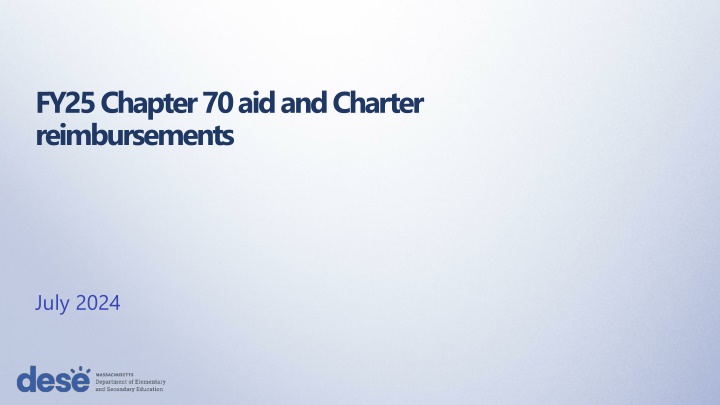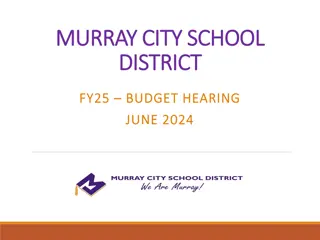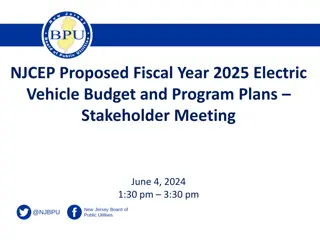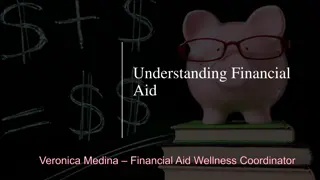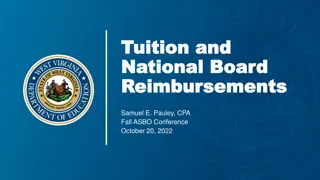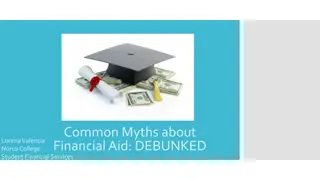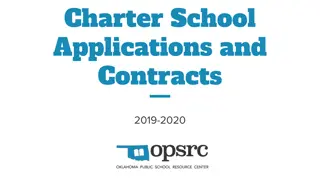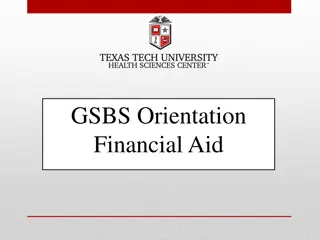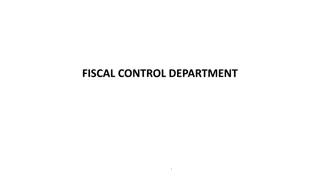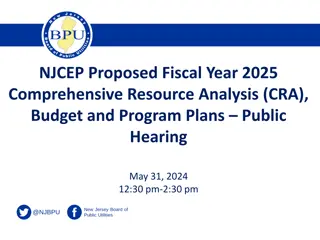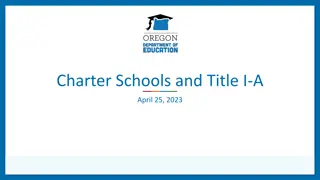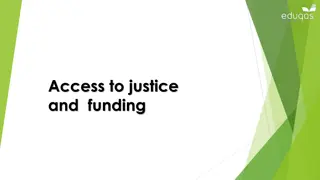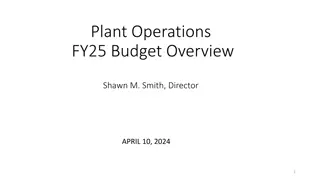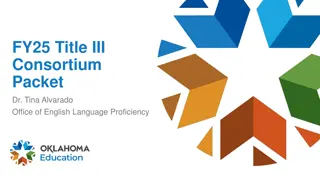FY25 Chapter 70 Aid and Charter Reimbursements Overview
In FY25, Chapter 70 aid and charter reimbursements see a $309 million increase, establishing higher foundation budget rates in key areas like benefits, guidance services, and special education. The Student Opportunity Act drives these changes, with emphasis on support for low-income and English learner students. Enrollment criteria, including low-income thresholds and special education rates, have been adjusted to better serve students in need. The SOA is in its fourth year of implementation, aiming to bridge funding gaps and enhance educational opportunities for all.
Download Presentation

Please find below an Image/Link to download the presentation.
The content on the website is provided AS IS for your information and personal use only. It may not be sold, licensed, or shared on other websites without obtaining consent from the author.If you encounter any issues during the download, it is possible that the publisher has removed the file from their server.
You are allowed to download the files provided on this website for personal or commercial use, subject to the condition that they are used lawfully. All files are the property of their respective owners.
The content on the website is provided AS IS for your information and personal use only. It may not be sold, licensed, or shared on other websites without obtaining consent from the author.
E N D
Presentation Transcript
FY25 Chapter 70 aid and Charter reimbursements July 2024 1
FY25 Chapter 70 continues implementation of the Student Opportunity Act(the SOA) FY25 Chapter 70 is $6,901,918,685, a $309 million increase (4.7%) over FY24 The SOA establishes new, higher foundation budget rates in 5 areas: Benefits and fixed charges Guidance and psychological services Special education out-of-district tuition English learners Low-income students FY25 Chapter 70 includes rate changes above inflation toward the goal rates in these 5 areas and closes an additional 1/6thof the gap FY25 will be the fourth year of implementation of the SOA 3
The low-income threshold is 185% of the federal poverty level in accordance with the SOA The SOA restores the definition of low-income enrollment used prior to FY17, based on 185% of the federal poverty level, up from the 133% threshold used for the economically disadvantaged match from FY17 to FY22 Statewide low-income enrollment for FY25 is 415,821, compared to 421,305 for FY24 Starting in FY23, the Department has designated a student enrolled on October 1st as low income if the student is: Identified as participating in state public assistance programs, including the Supplemental Nutrition Assistance Program, Transitional Aid to Families with Dependent Children, MassHealth, and foster care; or Verified as low income through a supplemental data collection process; or Reported as homeless through the McKinney-Vento Homeless Education Assistance program application 4
The SOA also increases the assumed in-district special education enrollment percentages The SOA increases the rate for vocational students from 4.75% to 5% and from 3.75% to 4% for non-vocational students Proposed rate increases for FY25 close an additional 1/6thof the gaps, so the factors used for FY25 are 4.93% and 3.93%, respectively 5
On top of the targeted rate increases, all foundation budget categories have been adjusted upward for inflation An employee benefits inflation rate is applied to the employee benefits and fixed charges category Based on the enrollment-weighted, three-year average premium increase for all GIC plans For FY25 the increase is 5.03% An inflation increase of 1.35% has been applied to all other foundation budget rates, based on the U.S. Department of Commerce s state and local government price deflator 6
The SOA also adds a new minimum aid adjustment to the formula This provision provides hold harmless aid to operating districts that otherwise would have lost aid due to the foundation budget factors Determines the aid that these districts would have received if foundation budget rates were only increased by inflation If this amount is higher than the revised formula amount, districts get the higher amount 7
The SOA codified the aggregate wealth model for determining local contribution requirements For municipalities with required contributions above targets, the requirement is reduced by 100% of the gap Cities and towns with combined effort yields greater than 175% of foundation have required local contributions set at not less than 82.5% of foundation Due to rapid increases to foundation, many communities are below target and fewer are eligible for excess effort reductions 236 communities are subject to below effort increments to bring their contributions closer to target compared to 48 in FY21 (year prior to implementation of the SOA) 65 communities are eligible for excess effort reduction compared to 201 in FY21 8
Tuition rates for Commonwealth charter schools are based on the same foundation budget rates used in Chapter 70 Foundation budget rate increases being implemented in FY25 have been incorporated into our projected FY25 tuition rates In addition, charter school low-income enrollment for FY25 has been identified using the same eligibility criteria used for districts (see slide 4) 10
FY25 implements the 3-year (100%/60%/40%) schedule for transition aid tied to year over year tuition growth Funding for first year reimbursements is prioritized over funding for second year reimbursements The reimbursement formula for transitional aid to districts reflects the change enacted by Section 38 of the FY20 budget, with an entitlement of 100% of any tuition increase in the first year, 60% in the second year, and 40% in the third year The SOA requires that 100% of the total state obligation to be funded in FY25 FY25 budget allocates $199.0 million for these reimbursements This appropriation level is expected to meet the 100% requirement when tuition assessments are updated to reflect actual enrollments and district spending levels The facilities component of the tuition rate is $1,188 per pupil, with this cost fully reimbursed by the state as in prior years 11
Calculating Chapter 70 local contribution requirements and state aid 12 12
Goal of the Chapter 70 formula To ensure that every district has sufficient resources to meet its foundation budget spending level, through an equitable combination of local property taxes and state aid. 13
The updated formula includes three parameters to be specified in each year s general appropriations act For FY25, these are specified as: Total state target local contribution = 59% Effort reduction = 100% Minimum aid = $104 per pupil 14
There are 6 factors that work together to determine a districts Chapter 70 aid Foundation Budget Enrollment Wage Adjustment Factor Inflation Local Contribution Property value Income Municipal Revenue Growth Factor 15
There are three primary steps in determining each districts Chapter 70 aid Determine an equitable local contribution requirement, how much of the foundation budget that should be paid for by each city and town s property tax, based upon the relative wealth of the municipality Define and calculate a foundation budget for each district, given the specific grades, programs, and demographic characteristics of its students Calculate state aid, providing necessary funds to reach foundation or mandated minimum aid increases Required Local Contribution + State Aid = a district s net school spending (NSS) requirement This is the minimum amount that a district must spend to comply with state law 16
Each district's foundation budget is calculated by multiplying the number of pupils in 13 enrollment categories by cost rates in 11 functional areas All students are counted in categories 1 7; special education, English learner, and low-income costs are treated as costs above the base and are captured in 8 13 17
Foundation budgets vary based on student needs, including concentrations of low-income students Foundationbudget per pupil, by low-income % range 0.00 - 5.99% $12,065 6.00 - 11.99% $12,745 12.00 - 17.99% $13,046 18.00 - 23.99% $13,087 24.00 - 29.99% $13,329 30.00 - 35.99% $13,985 36.00 - 41.99% $14,613 42.00 - 47.99% $15,427 48.00 - 53.99% $16,186 54.00 - 69.99% $16,997 70.00 - 79.99% $19,158 80.00%+ $19,775 State average $15,852 Note: Chart excludes vocational and agricultural districts. 18
Determining each municipalitys target local share starts with the local share of statewide foundation Statewide, determine percentages that yield from property and from income Determine target local share of statewide foundation Calculate statewide foundation budget 41% State aid $5.959 B Statewide foundation budget $14.535 B Income effort 1.4312% $4.288 B 59% Local contribution $8.576 B Property effort 0.3906% $4.288 B Property and income percentages are applied uniformly across all cities and towns to determine the combined effort yield from property and income. 19
An individual municipalitys target local share is based on its local property value, income, and foundation budget The sum of a municipality s local property and income effort equals its Combined Effort Yield (CEY) 2021 aggregate income X Statewide Income % 1.4312% 2022 EQV X Statewide Property 0.3906% CEY Target Local Share = CEY/Foundation budget (calculated at the city/town level) Capped at 82.5% of foundation (182 municipalities or 52% are capped) 20
Next the formula calculates each municipalitys preliminary local contribution (PLC) and makes adjustments relative to target to determine the required local contribution (RLC) Preliminary contribution Required contribution If the PLC as a % of foundation is more than target Reduce PLC by 100% of the gap Increase last year s required local contribution by the MRGF If the difference is < than 2.5%, the PLC is the new requirement If the PLC as a % of foundation is less than target If the difference is between 2.5% and 7.5%, add 1% to PLC Municipal Revenue Growth Factors (MRGF) are calculated annually by the Department of Revenue. MRGFs quantify the most recent annual % change in each municipality s local revenues, such as the annual increase in the Proposition 2 levy limit, that should be available for schools If the difference is > 7.5%, add 2% to PLC 21
Once a city or towns required local contribution is calculated, it is allocated among the districts to which it belongs Town of Orleans Foundation budget = $6.2M Required local contribution= $5.1M Cape Cod Regional Voc Tech 5% Cape Cod Regional Voc Tech 5% Orleans (K-5) 33% Orleans (K-5) 33% Nauset (6-12) 62% Nauset (6-12) 62% 22
Foundation aid provides additional funding for districts to spend at their foundation budgets Foundation budget Required local contribution = Foundation aid Start with prior year s aid Add together the prior year s aid and the required local contribution If this year s foundation aid exceeds last year s total Chapter 70 aid, the district receives the amount needed to ensure it meets its foundation budget (3) Foundation aid increase Prior year s aid (1) Foundation budget (2) This year s required local contribution 23
Calculating Chapter 70 aid: Districts are held harmless to previous aid levels and guaranteed at least a $30 per pupil increase Districts are held harmless to the previous year s level of aid 229 districts receive minimum aid increases of $104 per pupil in FY25 24
Districts receive different levels of Chapter 70 aid because their municipality s ability to pay differs 100% 90% 80% 70% 60% State Aid % Net School Spending Requirement 50% 40% Required Local Contribution 30% 20% 10% 0% Required Local Contribution + State Aid = a district s net school spending (NSS) requirement 25
The aggregate wealth model has eliminated required excess effort, but in recent years effort shortfalls have increased 800 600 400 200 Dollars Above/Below Target Local Share ($ Millions) 0 -200 -400 -600 -800 FY07 FY08 FY09 FY10 FY11 FY12 FY13 FY14 FY15 FY16 FY17 FY18 FY19 FY20 FY21 FY22 FY23 FY25 excess effort before effort reduction net excess after effort reduction shortfall below target before increment net shortfall below target after increment For communities that are below target, recent expansions in foundation budgets have resulted in required local contributions not keeping pace with the foundation budget increases 26
There are no longer any districts funded below target, while above target aid has increased aid above target aid below target 1,000 800 600 400 Dollars Above/Below Target Aid Share ($ Millions) 200 0 -200 -400 FY07 FY08 FY09 FY10 FY11 FY12 FY13 FY14 FY15 FY16 FY17 FY18 FY19 FY20 FY21 FY22 FY23 FY25 27
QUESTIONS? Rob O Donnell, Director of School Finance Robert.F.O Donnell@mass.gov 781.338.6512 Meghan Ryan, State Aid Programs Manager Meghan.Ryan2@mass.gov 781.338.6507 28 28
